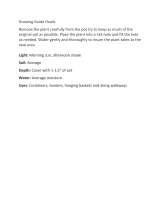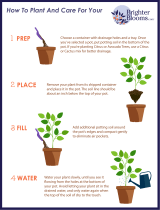Page is loading ...

Sunshine GardenHouseSunshine GardenHouse
Sunshine GardenHouseSunshine GardenHouse
Sunshine GardenHouse
™™
™™
™
PO Box 2068, Longview, WA 98632
Sunshine GardenHouseSunshine GardenHouse
Sunshine GardenHouseSunshine GardenHouse
Sunshine GardenHouse
™™
™™
™
PO Box 2068, Longview, WA 98632
User Guide
PO Box 2068
Longview, WA 98632
Toll Free: 888.272.9333
www.gardenhouse.com
Revised 9/29/03 JD
Sunshine GardenHouse
™

Sunshine GardenHouseSunshine GardenHouse
Sunshine GardenHouseSunshine GardenHouse
Sunshine GardenHouse
™™
™™
™
PO Box 2068, Longview, WA 98632
Sunshine GardenHouseSunshine GardenHouse
Sunshine GardenHouseSunshine GardenHouse
Sunshine GardenHouse
™™
™™
™
PO Box 2068, Longview, WA 98632
1 6
Most of the GardenHouse User’s Guide has been excerpted from
Solar Greenhouses for
the Home, with permission from its publisher, Northeast Regional Agricultural Engineer-
ing Service.
Your GardenHouse
The importance of following the basic rules for enjoying your Gardenhouse operation
cannot be overemphasized. Venting and heating at the proper time helps maintain a
healthy environment for plant growth. General cleanliness reduces the chances for pests
and diseases to breed.
Cultural techniques may require modification from those used in the garden. Soil
should be lighter and drain better than many garden soils. Whether cultivation is in
ground bed, raised beds, or containers, it is necessary to prepare a soil mix especially for
indoor use and change it annually. Drainage holes in containers are as important as light
soil. Watering and fertilizing is based on plant growth, which is directly related to light
and temperature.
Fewer pests are usually found in a gardenhouse garden; however, the pests must be
controlled. Due to the enclosed nature of the gardenhouse, interrelated ventilation, and
proximity of family and pets, extreme caution must be exercised when using pesticides.
As much as possible us innocuous controls such as yellow sticky bands for white fly, soap
solutions for spider mites and alcohol swabs for mealy bug control.
Good air circulation reduces fungus diseases. In late spring, summer, and early fall,
ventilation to the outside will be necessary to prevent excessive temperature buildup. In
many areas, unless shade and ventilation are provided, the summer temperatures will be
too high for optimum vegetable growth in your gardenhouse.
Following are just a few suggestions for good greenhouse management:
1.
Do not use ammonia cleaners or brushes on the glazing. Mild detergents or soaps
and a soft cloth are recommended.
2. Don’t smoke in the GardenHouse.
3. Keep working surfaces clean.
4. Keep all utensils and tools clean; wash them after use.
5. Wash pots and flats after use.
6. Keep a log of crop production, fertilization, and insect control.
7. Wash hands before handling plants and after applying fertilizer or insecticides.
8. Don’t allow weeds to grow next to the GardenHouse.
9. Check any new plants coming in for evidence of pests or disease.
10. Use soilless materials such as perlite, vermiculite, peat moss, and sand in
various combinations.
11. Remove dead foliage from plants and soil.
12. Destroy diseased plants; do not leave them near the GardenHouse.
Lighting the GardenHouse
Supplementing sunlight with electric light is expensive and seldom done in either the
commercial or hobby greenhouse. Light can be added to extend the day length or
interrupt the night to control bud initiation of some flowers. Sometimes fluorescent
lighting is installed to grow plants under benches.
CAUTION: The GardenHouse is a damp, well-grounded area. Poor wiring can be
deadly. Be sure any wiring meets national and local electrical codes. A ground fault
circuit interrupter (GFCI) should be installed to prevent a shock and possible death.
Hire a licensed electrician to wire the GardenHouse if you are not familiar with
electrical codes and wiring.
Light Instensity
Light intensity is measured in footcandles or, in the metric system, in lux (1 lux = 10.76
footcandles). The natural light level on a bright, clear day can reach 10,000 to 12,000
footcandles while on a rainy day with heavy overcast, it may be as low as 200 footcandles.
Indoor Seedling Germinations and Propagation
Germinating seeds and cuttings being propagated need light levels of about 600 to
2000 footcandles to grow well. Fuor 40-watt cold white fluorescent lamps mounted 4”
away from plants in a white reflector on 2” centers will provide about 1000 footcandles of
illumination. Special high wattage fluorescent lamps must be used to achieve higher
levels at greater distances. The soil is sometimes heated to speed germination.
Ingenuity and care are required to maintain optimum temperatures and humidity for
propagation or germination under electric lights. Many plants do well when daytime
temperatures are 80ºF and night temperatures are 10º to 15º less.. Night temperatures
should not drop below 60ºF.

Sunshine GardenHouseSunshine GardenHouse
Sunshine GardenHouseSunshine GardenHouse
Sunshine GardenHouse
™™
™™
™
PO Box 2068, Longview, WA 98632
Sunshine GardenHouseSunshine GardenHouse
Sunshine GardenHouseSunshine GardenHouse
Sunshine GardenHouse
™™
™™
™
PO Box 2068, Longview, WA 98632
5 2
Ornamentals
Many ornamental crops tolerate low light and cold temperature. During the coldest
months, grow plants which tolerate 45ºF or less, such as pocket book plant (calceolaria),
cineraria, tulips, daffodils, begonias, bromeliads, geraniums and some orchids. Foliage
and succulent plants which tolerate low temperatures include araucaria, citrus, fatsia,
hedera, philodendron, podocarpus, agave, many cacti and lithops.
Vegetables
Table 1. Suitability of vegetable and herbs for production in the winter solar
GardenHouse setting.
TNELLECXEDOOGRIAFROOP
drahCssiwSseotamoTyrrehC
2
iloccorBsnaeB
ecutteLfaeLsnoinOneerGsreppeP
2
nroC
yreleCsrebmucuC
1
)epyTnaeporuE(
seotamoTegraL
2
storraC
elaKcilraGtnalpggE
2
sehsidaR
spinruTkeeLsaePdoPelbidEspinruT
sneerGdratsuMegabbaCsnoleM
1
lliDsdralloChsauqS
1
hcanipS
onagerO
yelsraP
marojraM
lisaB
lenneF
1
Listed poor because the are pollinated naturally by bees. They could be hand pollinated
and listed fair. European cucumbers are not noted sine they require no pollination.
2
Require warmer temperatures.
Most small wood stoves need to be refueled every 4 to 6 hours and do not keep a fire
overnight. A wood stove can be used to heat water to be stored in a tank for overnight
use. Although more difficult to ignite, coal burned in a stove will provide heat for 12
hours or longer.
Recent research has shown that many plants respond according to the average
temperature held during the night. Thus a wood or coal stove might be fired to start the
evening so the gardenhouse temperature is 70º. Then, as the fuel burns down, the
temperature may slowly drop to 50º by morning. But the plants in the gardenhouse grow
as if they are kept at 60º all night.
Heater Size
• HEATING: The formula for determining the proper heater size for winter operation of
a single-glazed gardenhouse is shown below. Because of the improved insulation of the
double-wall polycarbonate, you reduce this requirement by 40%.
A x D = BTU’s x Insulation Advantage = Reduced BTU’s Needed
A = Total surface are of the gardenhouse.
For a 6’ x 8’ GardenHouse, A = 240 square feet
For a 6’ x 12’ GardenHouse, A = 316 square feet
For a 8’ x 12’ GardenHouse, A = 400 square feet
D = Difference in degrees F between the gardenhouse temperature and the coldest
winter temperature. EXAMPLE: Desired gardenhouse temperature is 55º, winter’s lowest
temperatures is 10º. So, 55º - 10º = 45º.
BTU’s = British Thermal Units, the rating of heat output often listed on heating
products. A wattage rating can be converted to BTU’s by multiplying the watts x 3.413.
EXAMPLE: Using the 6’ x 8’ GardenHouse and temperatures above:
A = 240, D = 45, then, 240 x 45 = 11,025 BTU’s
Insulation Advantage = .6
So, 11,025 x .6 =
6,615 BTU’s needed
• COOLING: Virtually every climate has enough summer sun to overheat a
gardenhouse. Moving the GardenHouse to a shady location, draping shade cloth over the
GardenHouse or, in some areas, adding fans to assist circulation will be necessary to
protect plants. An optional Shade Cloth Kit is available.
An exhaust fan should have the capacity to completely change the air in the GardenHouse
within a couple of minutes. The 6’ x 8’ GardneHouse would require a fan rated at 285
CFM (cubic feet per minute) for maximum effect. The 6’ x 12’ would require 428 CFM,
and the 8’ x 12’ would require 570 CFM.

Sunshine GardenHouseSunshine GardenHouse
Sunshine GardenHouseSunshine GardenHouse
Sunshine GardenHouse
™™
™™
™
PO Box 2068, Longview, WA 98632
Sunshine GardenHouseSunshine GardenHouse
Sunshine GardenHouseSunshine GardenHouse
Sunshine GardenHouse
™™
™™
™
PO Box 2068, Longview, WA 98632
3 4
Table 2. General temperature Guidelines for best growth and quality of vegetable crops.
serutraepmeT
selbategeV
mumitpOmuminiMmumixaM
57-555458,yfislas,noino,keel,cilrag,sevihc,yrocihC
tollahs
56-06045
7
,stuorpsslessurB,iloccorb,naebdaorb,teeB
,elak,hsidaresroh,dralloc,drahc,egabbac
,lerros,agabatur,hsidar,pinsrap,ibarlhok
pinrut,hcanips
07-060508naebpans,naebamiL
57-060559dnalaeZweN,aepnrehtuoS,nrocteewS
hcanips
57-560509hsauqs,nikpmup,etoyahC
57-560609nolemksum,rebmucuC
57-568508otamot,reppepteewS
58-075659,ellesor,arko,ainyt
ram,reppeptoh,tnalpggE
nolemretaw,otatoptees
The inexperienced grower can easily overproduce sometimes. Scheduling crops to meet
your needs will come with experience and careful record keeping. Table 3 (below)
suggests space requirements for vegetables for a family of four. Table 2 (above) outlines
temperature guidelines for best growth and quality of vegetable crops.
Table 3. Space requirements for vegetables for a family of four.
breHroelbategeV
gnicapSlatoT
)teeFerauqS(
)sehcnI(gnicapS
dedeeNstnalP
)rebmuN(
drahCssiwS9219
ecutteLfaeL81903
yre
leC9921
sneerG01604
hcanipS01604
dnalliD(sbreH
eromeriuqrlenneF
)srehtonahtecaps
516 sdnik5fohcae4
seotamoTyrrehC6216
snoinO
neerG6327
srebmucuC6812
cilraG2321
keeL2321
egabbaC212121
sdralloC012101
iloccorB012101
toH,sreppeP6812
teewS,sreppeP6812
seotamoTegraL6423
t
nalpggE2421
saePdoPelbidE01304
Supplemental Heat
If the gardenhouse is to be maintained warm enough for good plant growth during the
entire winter, supplement heat is generally necessary. Several types of heaters are
available.
The electric heater is convenient, clean, efficient , and easy to install; but electric energy
is more expensive than other fuels. The heater should have a built-in thermostat and
circulation fan. Adequate electrical supply and wiring is required, and the size of the
existing electrical service may limit the number of new branch circuits which can be
added to service the greenhouse.
Space heater are commonly used to heat small GardenHouses. Some are completely
self-contained units with fan and heat exchanger that burn either natural gas or LP gas.
Other, not commonly used in small GardenHouses, have a fan and heat exchanger but use
hot water or steam from a central boiler as the heat source. Space heaters are often hung
overhead, but some fit through the wall so little space is lost and no special venting is
required. Units with fans that blow air horizontally give more uniform temperature
distribution than heaters that blow air vertically.
CAUTION: Some fuel-burning heaters must be vented to the outside because some of
the products of combustion are toxic to both people and plants. Be sure air for
combustion comes from outside the gardenhouse. Portable oil-fueled space heaters,
such as those used on construction projects, should not be used in GardenHouses.
Small kerosene burners are sold to heat small GardenHouses. These low-cost, handy
units have no fan or thermostatic control, so temperatures fluctuate and are less uniform
than in houses with more expensive heating systems. Even these small heaters should be
vented to the outside. In tightly constructed houses these heaters can use enough oxygen
to cause incomplete combustion which generates toxic gases. In addition, water vapor,
formed as part of any combustion process, may cause high humidities and potential
disease problems.
Electrical or gas-fired radiant panels hung over each bench or floor can be very
efficient for small areas. Equipment may be expensive and hard to find, however.
CAUTION: Heat lamps should be suspended by chains or cables and not by the
electrical cord.
Infrared lamps have been used to heat bedding plants grown in a gardenhouse in the
spring. These low-cost lamps are simple to install overhead so they do not require floor
space. A 150 to 200 watt heat lamp suspended 32” above the bed will heat a 3’ x 3’ area 15º
to 20º above the outside air temperatures. A thermostat can be installed to turn off lamps
at 45º to 50º F.
A small wood or coal stove can be used, if the fuel can be purchased economically. The
stove should be installed to meet all safety requirements, especially distances to combus-
tibles. Purchase a stove designed for the fuel you intend to burn. It is difficult to burn
coal in a stove designed for wood.
/



